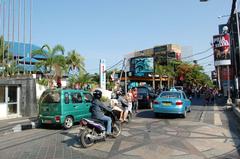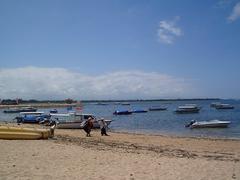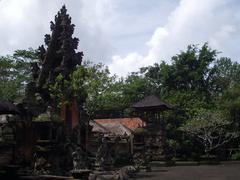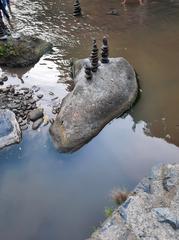Visiting Cultural Village Kertalangu in Denpasar: Hours, Tickets, and Tips
Date of Visit: 19/07/2024
Discover Cultural Village Kertalangu
Cultural Village Kertalangu, located in the heart of Denpasar, Bali, is a unique destination that offers an immersive experience into the traditional Balinese way of life. Established to preserve and promote Balinese culture, Kertalangu stands as a living museum where visitors can witness traditional farming methods, artisanal crafts, and religious ceremonies, all set against the backdrop of lush rice paddies. This cultural hub not only serves as a window into the past but also as an educational center that engages visitors in the rich tapestry of Balinese traditions and history (Kertalangu Cultural Village).
The village’s historical significance is rooted in its origins dating back to the Majapahit era in the 14th century, a time when the Majapahit Empire had a profound influence over much of Southeast Asia. This historical depth is reflected in the village’s architecture, which showcases traditional Balinese structures and temples, embodying the artistic and spiritual heritage of the region. Kertalangu is not merely a tourist attraction but a vibrant community dedicated to cultural preservation and education, making it an essential visit for anyone interested in experiencing the authentic Balinese way of life (TripAdvisor).
What You’ll Find in This Guide
- Introduction
- Historical Background
- Cultural Significance
- Architectural Heritage
- Religious and Spiritual Importance
- Visitor Information
- Visiting Hours
- Ticket Prices
- Travel Tips
- Nearby Attractions and Accessibility
- Special Events and Guided Tours
- Photographic Spots
- Preservation Efforts
- Economic Impact
- Modern Developments
- Challenges and Future Prospects
- FAQ
- Conclusion
Explore the Rich History and Visiting Tips for Kertalangu Cultural Village in Denpasar
Introduction
Are you looking to immerse yourself in the rich culture and history of Bali? Look no further than Kertalangu Cultural Village in Denpasar. This unique destination offers a window into traditional Balinese life, making it a must-visit for history buffs and cultural enthusiasts alike.
Historical Background
Cultural Village Kertalangu, located in Denpasar, Bali, Indonesia, is a site steeped in rich history and cultural significance. The village was established as part of a broader initiative to preserve and promote Balinese culture and traditions. The area where Kertalangu now stands has been inhabited for centuries, with archaeological evidence suggesting that it was a significant settlement during the Majapahit era in the 14th century. The Majapahit Empire, known for its influence over much of Southeast Asia, left a lasting cultural and architectural legacy in Bali, which is evident in the traditional Balinese structures and temples found within the village.
Cultural Significance
Kertalangu serves as a living museum, showcasing the traditional Balinese way of life. The village is designed to offer visitors an immersive experience into the daily activities and cultural practices of the Balinese people. This includes traditional farming methods, artisanal crafts, and religious ceremonies. The village is particularly known for its rice paddies, which are cultivated using age-old techniques passed down through generations. These paddies are not only a source of sustenance but also hold spiritual significance, as rice is considered a gift from the gods in Balinese Hinduism.
Architectural Heritage
The architecture of Kertalangu is a testament to Balinese craftsmanship and aesthetic principles. Traditional Balinese architecture is characterized by its use of natural materials such as bamboo, wood, and thatch, as well as its intricate carvings and decorations. The village features several traditional Balinese houses, known as “rumah adat,” which are built according to specific spatial and cosmological principles. These houses are often adorned with elaborate carvings depicting scenes from Hindu mythology and local folklore.
Religious and Spiritual Importance
Religion plays a central role in the life of Kertalangu’s inhabitants. The village is home to several temples, each dedicated to different deities and serving various religious functions. One of the most significant temples in Kertalangu is the Pura Dalem, which is dedicated to the god Shiva and serves as a place for important religious ceremonies and rituals. The temple’s architecture and layout are designed to facilitate the spiritual journey of worshippers, with various shrines and altars positioned according to sacred Balinese cosmology.
Visitor Information
Visiting Hours
Kertalangu Cultural Village is open daily from 8:00 AM to 6:00 PM, allowing visitors ample time to explore the various attractions and activities.
Ticket Prices
The entrance fee for Kertalangu Cultural Village is IDR 50,000 for adults and IDR 25,000 for children. Guided tours are available for an additional fee, providing deeper insights into the village’s history and culture.
Travel Tips
- Wear comfortable clothing and footwear, as there is a lot of walking involved.
- Bring a hat and sunscreen to protect yourself from the sun.
- Respect local customs and dress modestly, especially when visiting temples.
Nearby Attractions and Accessibility
Kertalangu Cultural Village is conveniently located near several other attractions in Denpasar, including the Bali Museum and the Bajra Sandhi Monument. The village is easily accessible by car or motorcycle, with ample parking available on-site.
Special Events and Guided Tours
Kertalangu Cultural Village hosts various cultural events and festivals throughout the year, offering visitors a chance to experience traditional Balinese music, dance, and cuisine. Guided tours are available in multiple languages, providing a comprehensive overview of the village’s history and significance.
Photographic Spots
The village offers numerous picturesque spots for photography, including the lush rice paddies, traditional Balinese houses, and intricately designed temples. These locations provide the perfect backdrop for capturing memories of your visit.
Preservation Efforts
Efforts to preserve and promote the cultural heritage of Kertalangu are ongoing. The village is supported by both local and international organizations dedicated to cultural preservation. These efforts include the restoration of historical structures, the documentation of traditional practices, and the promotion of cultural tourism. The village also serves as an educational center, offering workshops and programs aimed at teaching visitors about Balinese culture and traditions.
Economic Impact
Cultural Village Kertalangu has also had a significant economic impact on the local community. The village attracts thousands of tourists each year, providing a source of income for local artisans, farmers, and business owners. The revenue generated from tourism is reinvested into the community, supporting infrastructure development and cultural preservation initiatives. This sustainable tourism model ensures that the benefits of tourism are shared equitably among the local population.
Modern Developments
In recent years, Kertalangu has embraced modern developments while maintaining its cultural integrity. The village has incorporated modern amenities and facilities to enhance the visitor experience, including guided tours, interactive exhibits, and cultural performances. These developments have made Kertalangu more accessible to a global audience, allowing more people to experience and appreciate Balinese culture.
Challenges and Future Prospects
Despite its success, Kertalangu faces several challenges. The increasing number of tourists poses a threat to the village’s cultural and environmental sustainability. Efforts are being made to manage tourism in a way that minimizes its impact on the local community and environment. This includes implementing sustainable tourism practices, such as limiting the number of visitors, promoting eco-friendly activities, and encouraging responsible tourism behavior.
Looking to the future, Kertalangu aims to continue its mission of cultural preservation and education. The village plans to expand its educational programs, offering more opportunities for visitors to learn about Balinese culture and traditions. Additionally, Kertalangu is exploring ways to leverage technology to enhance the visitor experience, such as virtual tours and interactive digital exhibits.
FAQ
What are the visiting hours for Kertalangu Cultural Village?
Kertalangu Cultural Village is open daily from 8:00 AM to 6:00 PM.
Are there guided tours available at Kertalangu Cultural Village?
Yes, guided tours are available for an additional fee and provide deeper insights into the village’s history and culture.
What is the entrance fee for Kertalangu Cultural Village?
The entrance fee is IDR 50,000 for adults and IDR 25,000 for children.
Conclusion
Cultural Village Kertalangu stands as a beacon of Balinese culture and heritage. Its rich history, cultural significance, and commitment to preservation make it a must-visit destination for anyone interested in experiencing the authentic Balinese way of life. Through its efforts to balance tradition and modernity, Kertalangu continues to thrive as a cultural and economic hub, ensuring that the legacy of Balinese culture is preserved for future generations.
For more information, you can visit the official Kertalangu Cultural Village website.
Call to Action
Don’t miss the opportunity to explore Kertalangu Cultural Village! Plan your visit today and immerse yourself in the rich cultural heritage of Bali. Follow us on social media for more updates and travel tips.
Complete Visitor Guide - Cultural Village Kertalangu in Denpasar – Tickets, Hours, and Tips
Best Time to Visit
The ideal time to visit Cultural Village Kertalangu is during the dry season, which spans from April to October. During these months, the weather is generally sunny and less humid, making it perfect for outdoor activities and exploration. The wet season, from November to March, can bring heavy rains and high humidity, which might limit some activities.
Getting There
Cultural Village Kertalangu is located in Denpasar, the capital city of Bali. The village is approximately 15 kilometers from Ngurah Rai International Airport, making it easily accessible by taxi or private car. For those staying in Denpasar, local transportation options such as taxis, motorbike rentals, and ride-hailing services like Gojek and Grab are convenient ways to reach the village.
Entrance Fees and Operating Hours
The entrance fee to Cultural Village Kertalangu is relatively affordable, typically around IDR 20,000 (approximately USD 1.40) for adults and IDR 10,000 (approximately USD 0.70) for children. The village is open daily from 8:00 AM to 6:00 PM. It is advisable to check the official website or contact the village directly for the most up-to-date information on entrance fees and operating hours.
History and Cultural Significance
Cultural Village Kertalangu is not just a tourist attraction but a living museum that preserves and promotes the rich heritage of Bali. The village showcases traditional Balinese architecture, art, and customs, offering visitors an immersive experience into the island’s cultural and historical landscape.
Dress Code and Etiquette
Visitors are encouraged to dress modestly and comfortably. Lightweight, breathable clothing is recommended due to the tropical climate. When visiting temples or participating in cultural ceremonies, it is respectful to wear a sarong and sash, which can often be rented or purchased at the village. Additionally, always remove your shoes before entering any sacred spaces.
Guided Tours and Activities
To fully appreciate the cultural and historical significance of Kertalangu, consider joining a guided tour. These tours are often led by knowledgeable local guides who can provide in-depth insights into the village’s history, traditions, and daily life. Activities such as traditional Balinese dance performances, cooking classes, and handicraft workshops are also available and offer a hands-on experience of Balinese culture.
Photography Tips
Cultural Village Kertalangu is a picturesque location with numerous photo opportunities. When taking photographs, be mindful of local customs and avoid taking pictures of people without their permission, especially during religious ceremonies. Early morning and late afternoon provide the best lighting conditions for photography, with softer light and fewer shadows.
Health and Safety
- Hydration: The tropical climate can be quite hot and humid, so it is essential to stay hydrated. Carry a reusable water bottle and refill it at designated water stations.
- Sun Protection: Wear sunscreen, a hat, and sunglasses to protect yourself from the sun. Long sleeves and pants can also provide additional protection.
- Insect Repellent: Mosquitoes can be prevalent, especially during the wet season. Use insect repellent to avoid bites and potential mosquito-borne diseases.
- Emergency Contacts: Familiarize yourself with local emergency contact numbers and the location of the nearest medical facilities.
Local Cuisine and Dining
Cultural Village Kertalangu offers a variety of dining options where visitors can sample traditional Balinese cuisine. Popular dishes include Nasi Goreng (fried rice), Mie Goreng (fried noodles), and Satay (grilled skewers). Many eateries within the village use fresh, locally sourced ingredients, providing an authentic taste of Balinese flavors. For those with dietary restrictions, it is advisable to inform the restaurant staff in advance.
Shopping and Souvenirs
The village has several shops and stalls selling traditional Balinese handicrafts, textiles, and souvenirs. Popular items include batik fabrics, wood carvings, and silver jewelry. Purchasing these items not only provides a memorable keepsake but also supports local artisans and the community.
Environmental Responsibility
Visitors are encouraged to practice responsible tourism by minimizing their environmental impact. This includes disposing of waste properly, using reusable bags and bottles, and respecting the natural surroundings. Participating in eco-friendly activities and supporting local conservation efforts can also contribute to the sustainability of the village.
Cultural Sensitivity
Respect for local customs and traditions is paramount when visiting Cultural Village Kertalangu. Engage with the local community with an open mind and a respectful attitude. Learning a few basic phrases in Bahasa Indonesia or Balinese can go a long way in building rapport with the locals. Simple greetings like “Selamat pagi” (Good morning) and “Terima kasih” (Thank you) are always appreciated.
Accessibility
While Cultural Village Kertalangu strives to be inclusive, some areas may have limited accessibility for visitors with mobility challenges. It is advisable to contact the village in advance to inquire about specific accessibility accommodations and services.
Additional Resources
For more information and updates on Cultural Village Kertalangu, visitors can refer to the official website or follow their social media pages. Travel forums and review sites like TripAdvisor also provide valuable insights and tips from fellow travelers.
FAQ
- What are the Cultural Village Kertalangu visiting hours? The village is open daily from 8:00 AM to 6:00 PM.
- How much are the tickets for Cultural Village Kertalangu? The entrance fee is around IDR 20,000 for adults and IDR 10,000 for children.
- What is the best way to get to Cultural Village Kertalangu? It is easily accessible by taxi or private car from Ngurah Rai International Airport or by local transportation options in Denpasar.
Conclusion
By following these tips and guidelines, visitors can ensure a safe, enjoyable, and culturally enriching experience at Cultural Village Kertalangu. Don’t forget to check out other related posts, download the Audiala mobile app for more travel tips, and follow our social media for the latest updates.
Summing Up Your Visit to Kertalangu
Cultural Village Kertalangu in Denpasar is more than just a tourist destination; it is a beacon of Balinese culture and heritage. Its rich history, cultural significance, and commitment to preservation make it a must-visit for those interested in immersing themselves in the traditional Balinese way of life. From the intricate architecture and sacred temples to the vibrant cultural performances and artisanal workshops, Kertalangu offers a comprehensive and enriching experience that highlights the beauty and depth of Balinese traditions (Bali Museum).
As a living museum, Kertalangu continues to thrive by balancing tradition with modernity, ensuring that the cultural heritage of Bali is preserved for future generations. The village’s efforts in sustainable tourism and cultural education not only provide economic benefits to the local community but also promote a deeper understanding and appreciation of Balinese culture among visitors. By visiting Kertalangu, you contribute to the ongoing preservation of this cultural gem, allowing it to remain a vibrant and integral part of Bali’s heritage (Bajra Sandhi Monument).
Further Reading and Sources
- Kertalangu Cultural Village. (n.d.). Retrieved from Kertalangu Cultural Village
- TripAdvisor. (n.d.). Cultural Village Kertalangu. Retrieved from TripAdvisor
- Bali Museum. (n.d.). Retrieved from Bali Museum
- Bajra Sandhi Monument. (n.d.). Retrieved from Bajra Sandhi Monument




